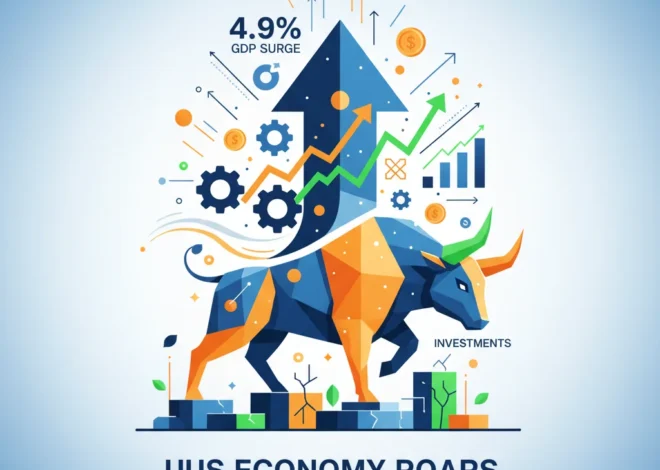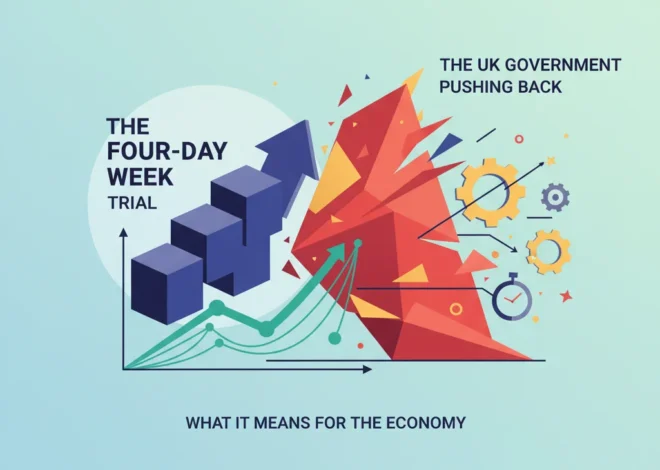
The Font of All Money: How Typography Shapes Investor Trust and the Global Economy
What does your bank’s logo really say about your money? On the surface, it’s just a name, a symbol. But beneath that lies a silent, powerful communicator: the font. We rarely give it a second thought, yet the choice of typeface—the subtle curves of a “G” or the sharp, clean line of a “T”—is a multi-million dollar decision that profoundly influences our perception of stability, innovation, and trust. This is the hidden language of the financial world, where typography isn’t just an aesthetic choice; it’s a strategic asset that can move markets and shape the future of the global economy.
This fascinating connection between place, identity, and typography was recently highlighted in a letter to the Financial Times by Mark Bessoudo. He observed that certain fonts seem to belong to certain cities: the Johnston typeface is intrinsically linked with the London Underground, Helvetica is the unofficial script of the New York City subway, and Garamond evokes the classic elegance of Paris. This concept of “typographic terroir” is more than a design curiosity. It’s a foundational principle that underpins the branding of the world’s most powerful financial institutions, from centuries-old banks to disruptive fintech startups.
In this analysis, we will explore how this silent language of fonts dictates brand perception in the high-stakes world of finance. We’ll examine the psychological triggers embedded in serif and sans-serif typefaces, analyze how financial giants leverage typography to project power and stability, and see how fintech challengers use it to signal a revolution in banking and investing.
The Silent Psychology of a Font: Serif vs. Sans-Serif in Finance
At its core, the typographic battle in the financial industry is a tale of two font families: serif and sans-serif. The choice between them is a fundamental declaration of a company’s identity and its place in the economic order.
Serif fonts, with their small decorative strokes (or “feet”) at the end of letters, are the bedrock of traditional finance. Typefaces like Times New Roman, Garamond, and Bodoni exude a sense of history, authority, and reliability. Their roots trace back to Roman inscriptions and the dawn of printing. Psychologically, they communicate permanence and trustworthiness. When a wealth management firm or an established investment bank uses a serif font, they are subconsciously telling you: “We have been here for centuries. We have weathered every storm in the stock market. Your capital is safe with us.” It’s no coincidence that publications of record, like The Wall Street Journal and The New York Times, use serif fonts to convey journalistic authority.
Sans-serif fonts, lacking these decorative strokes, are the language of modernity, efficiency, and disruption. Typefaces like Helvetica, Futura, and, more recently, a plethora of geometric “grotesk” fonts, are clean, direct, and approachable. They emerged in the 19th and 20th centuries as the script of commerce and technology. In the world of financial technology, a sans-serif font signals a break from the past. It tells the user: “We are different. We are simple, transparent, and digital-first. We are not your grandfather’s bank.” This visual language is crucial for companies aiming to reduce the perceived complexity of trading and investing for a new generation.
According to research on font psychology, these associations are deeply ingrained. A study might show that consumers perceive serif fonts as more “stable” and “traditional,” while sans-serif fonts are seen as more “modern” and “innovative.” This isn’t just about aesthetics; it’s about managing perception, which is a cornerstone of the financial industry.
Beyond the Basics: Four Pillars of Financial Mastery in the Modern Economy
Typographic Terroir: How Global Financial Hubs Project Their Identity
Expanding on the original letter’s premise, we can see how the typographic identity of a city often mirrors the character of its financial district. The fonts that define a city’s public life become intertwined with its economic identity, creating a powerful brand halo for the institutions headquartered there.
Below is a table exploring this connection between city, font, and financial character:
| Financial Hub | Iconic Typeface(s) | Associated Traits | Reflection in the Financial Sector |
|---|---|---|---|
| London | Johnston, Gill Sans | Orderly, historic, reliable, formal | Represents the City of London’s reputation for tradition, regulatory strength, and long-established trust in global banking. |
| New York | Helvetica, Franklin Gothic | Pragmatic, direct, bold, efficient | Mirrors the no-nonsense, fast-paced environment of Wall Street, focused on clarity, execution, and the bottom line in trading and capital markets. |
| Zurich | Univers, Akzidenz-Grotesk | Neutral, precise, clean, discreet | Embodies the Swiss principles of precision, privacy, and neutrality that are the hallmarks of its world-renowned private banking sector. |
| Silicon Valley | SF Pro, Roboto, Custom Sans-Serifs | Humanist, approachable, innovative, clean | The epicenter of fintech innovation. The typography is designed for screens, prioritizing user experience and approachability to democratize finance. |
Case Studies: The Typographic Arms Race in Finance
The theoretical battle between fonts plays out every day in the branding of financial companies. Their typographic choices are deliberate, strategic, and reflective of their core business model.
The Old Guard: Projecting Unshakeable Stability
Legacy institutions like Goldman Sachs, J.P. Morgan, and BlackRock traffic in one primary currency: trust. Their typography must reflect this. In 2020, Goldman Sachs unveiled its first-ever custom font, “Goldman Sans.” It’s a clean, modern sans-serif, but it’s built with geometric precision and a sense of weight that feels solid and engineered. The message is clear: we are a modern, forward-thinking institution, but we are still the same stable, powerful Goldman Sachs. The font was a key part of a broader strategy to appear more accessible and tech-focused without sacrificing its aura of elite authority, a crucial move in the modern economics of brand perception.
The Fintech Disruptors: The A-B-C of Accessibility
Contrast this with the branding of a company like Stripe, a titan of financial technology. Its website and branding use a clean, light, and airy sans-serif font. The typography feels effortless and simple, mirroring the company’s core value proposition: making complex payment processing incredibly easy for developers. Similarly, retail trading apps like Robinhood and neo-banks like Chime use friendly, rounded sans-serif fonts that feel more like a social media app than a financial institution. This is an intentional strategy to lower the barrier to entry and reduce the intimidation factor associated with investing and finance. As one brand strategist noted in a Forbes article, for fintechs, “design isn’t just a wrapper; it’s the product,” and typography is the first handshake with the user.
The Hidden Capital in Your Utility Bill: Unlocking Dormant Assets in a Digital Economy
The Crypto Frontier: The Bleeding Edge of Branding
The world of blockchain and cryptocurrency takes typographic signaling to another level. Here, the goal is often to signal a radical departure from the entire existing financial system. Brands in this space often use futuristic, extended, or even pixelated fonts. This visual language appeals to a user base that values decentralization, technological sovereignty, and high-risk, high-reward ventures. The typography is intentionally niche; it’s designed to attract a specific community while potentially alienating the mainstream, a branding strategy that mirrors the technology’s current stage of adoption.
The ROI of Typography: A Tangible Investment
For business leaders and investors, the key question is whether this focus on fonts has a measurable impact on the bottom line. The answer is an emphatic yes. Brand value, a significant intangible asset on a company’s balance sheet, is directly influenced by the consistency and effectiveness of its visual identity, with typography at its core.
A major rebranding, which almost always includes a typographic overhaul, is a significant capital expenditure. Companies can spend millions developing a custom font family. Why? Because a unique, proprietary font is an ownable asset that reinforces brand recognition at every single touchpoint, from a mobile app to a shareholder report. According to annual reports on brand valuation, the world’s most valuable brands, including many in the financial and tech sectors, invest heavily in creating a cohesive and instantly recognizable visual language.
Consider Google’s 2015 switch to its custom font, Product Sans. The change was part of a massive rebranding that coincided with the formation of its parent company, Alphabet. The new, friendlier font signaled a more unified and accessible brand ecosystem. This wasn’t just a cosmetic change; it was a strategic move to reposition the company for its next phase of growth, reflecting a shift in its role in the global economy. For a financial institution, a well-executed typographic update can signal a successful merger, a new strategic direction, or a renewed commitment to innovation, all of which can positively influence investor sentiment and the stock market.
UK's £420M Lifeline for Heavy Industry: A Strategic Investment or a Drop in the Ocean?
Conclusion: The Enduring Power of a Well-Chosen Letter
From the historic streets of London to the digital wallets of the fintech revolution, typography acts as a powerful, silent narrator of our financial lives. It tells us who to trust, what to value, and where the future of money is headed. The simple observation that a font can “belong” to a city reveals a deeper truth: visual identity is inextricably linked to economic identity.
For investors, understanding this visual language provides another layer of analysis when evaluating a company’s strategy and its connection with its target market. For business leaders, it underscores that design is not a superficial expense but a core investment in the most valuable asset of all: trust.
As the world of finance becomes increasingly complex—driven by algorithms, blockchain ledgers, and globalized digital platforms—the simple, human-centric choice of a font remains one of the most potent tools we have. It is the first and last impression, shaping our decisions in ways we are only just beginning to understand. In the end, the letters that form a company’s name are just as important as the numbers on its balance sheet.


